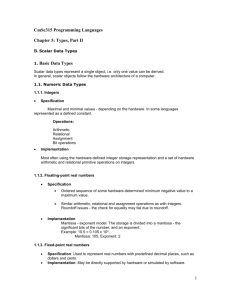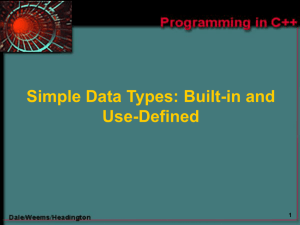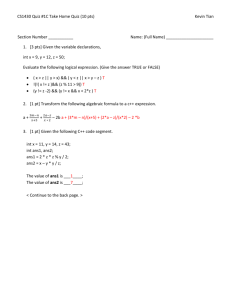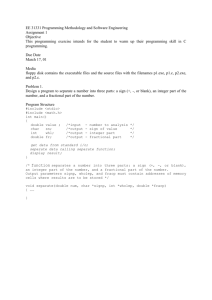Chap10ND
advertisement
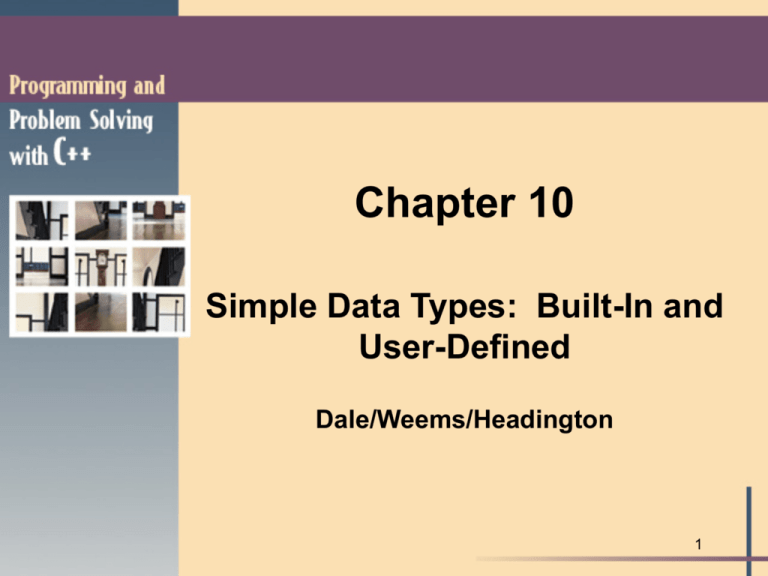
Chapter 10
Simple Data Types: Built-In and
User-Defined
Dale/Weems/Headington
1
Chapter 10 Topics
External and Internal Representations of Data
Integral and Floating Point Data Types
Using Combined Assignment Operators
Prefix and Postfix Forms of Increment and
Decrement Operators
Using Ternary Operator
Using Type Cast Operator
Using an Enumeration Type
Creating and Including User-Written Header
Files
2
Enumeration Types
3
C++ Data Types (enum)
simple
integral
enum
structured
floating
array struct union class
char short int long bool
float double long double address
pointer
reference
4
typedef statement
typedef creates an additional name for an
already existing data type
before bool type became part of ISO-ANSI C++,
a Boolean type was simulated this way
typedef int Boolean;
const Boolean true = 1 ;
const Boolean false = 0 ;
.
.
.
Boolean dataOK ;
.
.
.
dataOK = true ;
5
Enumeration Type
A user-defined data type
whose
domain is
an ordered set of literal values
expressed as identifiers
Enumerator
one
of the values
in the domain of an enumeration type
Declaring Enumeration Types
Syntax:
enum NewTypeName { List };
where
NewTypeName
is a valid identifier
List is a list of items, each of which is
– Identifier
OR
– Identifier = IntegerConstant
Enumeration Types
C++ allows creation of a new simple type by
listing (enumerating) all the ordered values in
the domain of the type
EXAMPLE
enum MonthType { JAN, FEB, MAR, APR, MAY, JUN,
JUL, AUG, SEP, OCT, NOV, DEC } ;
name of new type
list of all possible values of this new type
8
Enumeration Example
enum Days {SUN, MON, TUE, WED, THU, FRI, SAT};
The effect of the enum is the same as:
typedef int Days;
const int SUN = 0;
const int MON = 1;
const int TUE = 2;
const int WED = 3;
const int THU = 4;
const int FRI = 5;
const int SAT = 6;
enum Type Declaration
enum MonthType { JAN, FEB, MAR, APR, MAY, JUN,
JUL, AUG, SEP, OCT, NOV, DEC } ;
the enum declaration creates a new programmerdefined type and lists all the possible values of that
type--any valid C++ identifiers can be used as values
the listed values are ordered as listed. That is, JAN <
FEB < MAR < APR , and so on
you must still declare variables of this type
10
Declaring enum Type Variables
enum MonthType { JAN, FEB, MAR, APR, MAY, JUN,
JUL, AUG, SEP, OCT, NOV, DEC } ;
MonthType thisMonth;
MonthType lastMonth;
// declares 2 variables
// of type MonthType
lastMonth = OCT ;
thisMonth = NOV ;
// assigns values
// to these variables
.
.
.
lastMonth = thisMonth ;
thisMonth = DEC ;
11
Storage of enum Type Variables
stored as 0
stored as 1
stored as 2
stored as 3 etc.
enum MonthType { JAN, FEB, MAR, APR, MAY, JUN,
JUL, AUG, SEP, OCT, NOV, DEC } ;
stored as 11
12
Use Type Cast to Increment
enum Type Variables
enum MonthType { JAN, FEB, MAR, APR, MAY, JUN,
JUL, AUG, SEP, OCT, NOV, DEC } ;
MonthType thisMonth;
MonthType lastMonth;
lastMonth = OCT ;
thisMonth = NOV ;
lastMonth = thisMonth ;
thisMonth = thisMonth++ ;
// COMPILE ERROR !
thisMonth = MonthType( thisMonth + 1) ; // uses type cast
13
Example Enumerations:
enum CoolCars {LAMBORGHINI, BMW, PORSCHE, FERRARI, LOTUS};
enum ClassicTV {BEVERLYHILLBILLIES, GILLIGANSISLAND, BATMAN,
ILOVELUCY, OUTERLIMITS, TWILIGHTZONE};
enum Department {CSC, MATH, BIOL, CHEM, PHYS, ENGR};
enum Boolean {FALSE, TRUE};
Data type Boolean has two values:
FALSE (0) and TRUE (1)
enum EscapeSequence {NEWLINE = '\n', HORIZTAB = '\t',
VERTTAB = '\v', BACKSPACE = '\b'};
Enumeration Errors
enum Vowel {'A', 'E', 'I', 'O', 'U'};
enum Places {1st, 2nd, 3rd};
enum Starch {CORN,RICE,POTATO,BEAN};
enum Grain {WHEAT,CORN,RYE,BARLEY,SORGHUM};
More about enum Type
Enumeration type can be used in a Switch statement
for the switch expression and the case labels.
Stream I/O ( using the insertion << and extraction >>
operators ) is not defined for enumeration types.
Instead, functions can be written for this purpose.
Comparison of enum type values is defined using the
6 relational operators ( < , <= , > , >= , == , != ).
An enum type can be the return type of a valuereturning function in C++.
SOME EXAMPLES . . .
16
MonthType thisMonth;
switch ( thisMonth )
// using enum type switch expression
{
case JAN :
case FEB :
case MAR : cout << “Winter quarter” ;
break ;
case APR :
case MAY :
case JUN : cout << “Spring quarter” ;
break ;
case JUL :
case AUG :
case SEP : cout << “Summer quarter” ;
break ;
case OCT :
case NOV :
case DEC : cout << “Fall quarter” ;
}
17
Using enum type Control
Variable with for Loop
enum MonthType { JAN, FEB, MAR, APR, MAY, JUN,
JUL, AUG, SEP, OCT, NOV, DEC } ;
void WriteOutName ( /* in */ MonthType ) ;
// prototype
.
.
.
MonthType month ;
for (month = JAN ; month <= DEC ; month = MonthType (month + 1 ) )
{
// requires use of type cast to increment
WriteOutName ( month ) ;
.
.
.
}
// function call to perform output
18
void WriteOutName ( /* in */ MonthType month )
// Prints out calendar name corresponding to month
// Precondition:
month is assigned
// Postcondition:
calendar name for month has been written out
{
switch ( month )
{
case
case
case
case
case
case
case
case
case
case
case
case
}
}
JAN
FEB
MAR
APR
MAY
JUN
JUL
AUG
SEP
OCT
NOV
DEC
:
:
:
:
:
:
:
:
:
:
:
:
cout
cout
cout
cout
cout
cout
cout
cout
cout
cout
cout
cout
<<
<<
<<
<<
<<
<<
<<
<<
<<
<<
<<
<<
“ January ” ;
“ February ” ;
“ March ” ;
“ April ” ;
“ May ” ;
“ June ” ;
“ July ” ;
“ August ” ;
“ September ” ;
“ October ” ;
“ November ” ;
“ December ” ;
break ;
break ;
break ;
break ;
break ;
break ;
break ;
break ;
break ;
break ;
break ;
break ;
19
Function with enum type
Return Value
enum SchoolType { PRE_SCHOOL, ELEM_SCHOOL,
MIDDLE_SCHOOL, HIGH_SCHOOL, COLLEGE } ;
.
.
.
SchoolType GetSchoolData ( void )
// Obtains information from keyboard to determine school level
// Postcondition: Function value == personal school level
{
SchoolType schoolLevel ;
int
age ;
int
lastGrade ;
cout << “Enter age : “ ;
cin >> age ;
// prompt for information
20
if ( age < 6 )
schoolLevel = PRE_SCHOOL ;
else
{
cout << “Enter last grade completed in school : “ ;
cin >> lastGrade;
if ( lastGrade < 5 )
schoolLevel = ELEM_SCHOOL ;
else if ( lastGrade < 8 )
schoolLevel = MIDDLE_SCHOOL ;
else if ( lastGrade < 12 )
schoolLevel = HIGH_SCHOOL ;
else
schoolLevel = COLLEGE ;
}
return schoolLevel ;
// return enum type value
}
21
Data Types
22
Data Type
A specific set of data values
–for int, whole numbers
–from INT_MIN to INT_MAX
With a set of operations on those values
– for int: +,-,*,/,%,++,-– relational and logical operators
Simple Data Type
A data type
in
which each value
is atomic (indivisible)
'Q' is atomic
no
parts to be accessed individually
"Good Morning" is not atomic
it
is composed of several chars
C++ Simple Data Types
simple types
integral
char
short
int
long
floating
bool
enum
float
double
long double
unsigned
25
Data Type Requirements
26
By definition,
the size of a C++ char value is always 1 byte.
‘A’
exactly one byte of memory space
Sizes of other data type values in C++ are
machine-dependent.
27
Using one byte ( = 8 bits ),
0
1
1
0
0
0
1
1
HOW MANY DIFFERENT NUMBERS CAN BE
REPRESENTED USING 0’s and 1’s?
Each bit can hold either a 0 or a 1. So there are just
two choices for each bit, and there are 8 bits.
8
2 x 2 x 2 x 2 x 2 x 2 x 2 x 2 = 2 = 256
28
Similarly,
using two bytes ( = 16 bits),
0
1
1
0
0
1
16
= 65,536
2
1
0
0
1
0
0
1
0
1
DIFFERENT NUMBERS CAN BE REPRESENTED.
If we wish to have only one number representing the
integer zero, and half of the remaining numbers positive,
and half negative, we can obtain the 65,536 numbers in
the range below :
-32,768 . . . . 0 . . . . 32,767
29
0
Some Integral Types
Type
Size in Bytes
Minimum Value
Maximum Value
char
1
-128
127
short
2
-32,768
32,767
int
4
-2,147,483,648
2,147,483,647
long
4
-2,147,483,648
2,147,483,647
NOTE: Values given for one machine. Actual sizes are machine-dependent.
30
Decimal Constants
Examples
97
40000L
50000
389123487UL
65535U
427l
53100
42513999ul
int
long
long
uns long
uns int
long
long
uns long
The type of a constant
depends on its size
unless the type
specifier is used
–
–
–
–
–
–
U
L
UL
ul
LU
lu
Octal Constants
Examples
017
0577777L
01267333l
01267335
0482
0372
(illegal)
Always begins with 0
Type specifier may follow
Never contains 8 or 9
0372
= 382 + 781 + 280
Hexadecimal Constants
Hex digits include
0-9 plus
a or A = 10
b or B = 11
c or C = 12
d or D = 13
e or E = 14
f or F = 15
Examples
0x2C
0Xac12eL
0x67A
0x67A
= 6162 + 7161 + 10160
Operator sizeof
DEFINITION
C++ has a unary operator named sizeof that yields the
size on your machine, in bytes, of its single operand.
The operand can be a variable name, or it can be the
name of a data type enclosed in parentheses.
int age ;
cout << “Size in bytes of variable age is “ << sizeof age << endl ;
cout << “Size in bytes of type float is “ << sizeof ( float ) << endl ;
34
The only guarantees made by
C++ are . . .
1 = sizeof( char ) <= sizeof( short ) <= sizeof( int ) <= sizeof( long )
1 <= sizeof ( bool ) <= sizeof ( long )
sizeof ( float ) <= sizeof ( double ) <= sizeof ( long double )
char is at least 8 bits
short is at least 16 bits
long is at least 32 bits
35
Floating Point Data Types
36
Floating Point Types
Type
# Bytes
float
4
6
1.19E-38
3.4E+38
double
8
15
2.22E-308
1.79E+308
10
18
3.4E-4932
1.1E+4932
long double
# S.D. Minimum
Positive Value
Maximum
Positive Value
*Microsoft uses double
NOTE: Values given for one machine. Actual sizes are machine-dependent.
See rangeflo.cpp
37
Floating Point Constants
+/- digits.digits
+/- digits.digits E +/- digits
Examples
6.83
6.83F
6.83L
4.35E-9
double
float
long double
double
More about Floating Point Types
floating point constants in C++ like 94.6 without a
suffix are of type double by default
to obtain another floating point type constant a
suffix must be used
the suffix F or f denotes float type, as in 94.6F
the suffix L or l denotes long double, as in 94.6L
39
Header Files
climits and cfloat
contain constants whose values are the
maximum and minimum for your machine
such constants are FLT_MAX, FLT_MIN,
LONG_MAX, LONG_MIN
#include < climits >
using namespace std ;
.
.
.
cout << “Maximum long is “ << LONG_MAX << endl ;
cout << “Minimum long is “ << LONG_MIN << endl ;
40
Assignment Expressions
41
Assignment Expression
An assignment
assigns
a value to a variable
returns the value stored into the variable
delta = 2 * 12;
24 is stored in delta
24 is returned as the result of the assignment expression
Assignment Expression
A C++ expression with
(1)
a value and
(2) the side effect of storing the expression
value into a memory location
Expression Statement
A statement formed by appending a
semicolon to an expression
23;
2 * (alpha + beta);
Combined Assignment Operators
45
C++ Has Combined Assignment
Operators
int age ;
cin >> age ;
Write a statement to add 3 to age.
age = age + 3 ;
OR,
age += 3 ;
46
Write a statement to subtract 10 from weight
int weight ;
cin >> weight ;
weight = weight - 10 ;
OR,
weight -= 10 ;
47
Write a statement to divide money by 5.0
float money ;
cin >> money ;
money = money / 5.0 ;
OR,
money /= 5.0 ;
48
Write a statement to double profits
float profits ;
cin >> profits ;
profits = profits * 2.0 ;
OR,
profits *= 2.0 ;
49
Write a statement to raise cost 15%
float cost;
cin >> cost;
cost = cost + cost * .15 ;
OR,
cost = 1.15 * cost;
OR,
cost *= 1.15 ;
50
Increment/Decrement
51
Which form to use?
when the increment (or decrement)
operator is used in a “stand alone”
statement solely to add one (or subtract
one) from a variable’s value, it can be used
in either prefix or postfix form
USE EITHER
dogs-- ;
--dogs;
52
BUT...
when the increment (or decrement)
operator is used in a statement with
other operators, the prefix and
postfix forms can yield different
results
LET’S SEE HOW. . .
53
PREFIX FORM
“First increment, then use ”
int alpha ;
int num ;
13
num = 13;
alpha = ++num * 3;
num
alpha
14
num
14
42
num
alpha
54
POSTFIX FORM
“Use, then increment”
int alpha ;
int num ;
13
num = 13;
num
alpha = num++ * 3;
13
num
alpha
39
alpha
14
num
55
Type Cast Operator
The C++ cast operator is used to explicitly request a
type conversion. The cast operation has two forms.
int
intVar;
float floatVar = 104.8 ;
intVar = int ( floatVar ) ;
// functional notation, OR
intVar = ( int ) floatVar ;
// prefix notation uses ( )
104.8
104
floatVar
intVar
56
?: Operator
57
Ternary (three-operand) Operator
? :
SYNTAX
Expression1 ? Expression2 : Expression3
MEANING
If Expression1 is true (nonzero), then the value of the
entire expression is Expression2. Otherwise, the
value of the entire expression is Expression 3.
FOR EXAMPLE . . .
58
Using Conditional Operator
float Smaller ( float x, float y )
// Finds the smaller of two float values
// Precondition:
x assigned && y assigned
// Postcondition:
Function value == x, if x < y
//
== y, otherwise
{
float min;
min = ( x < y ) ? x : y ;
return min ;
}
59
Conditional Expression Examples
Find the absolute value of number:
number >= 0 ? number : -number
Find the larger of the two #’s x and y:
x >= y ? x : y
Associativity
61
Associativity
Grouping Order
Left Associative
a - b + c
(a - b) + c
NOT: a - (b + c)
Right Associative
sum = count = 0;
means
sum = (count = 0);
Operator Precedence
63
C++ Operator Precedence
(highest to lowest)
Operator
()
unary: ++ -- ! + - (cast) sizeof
*
/
%
+ < <= > >=
== !=
&&
||
?:
=
+=
-=
*=
/=
Associativity
Left to right
Right to left
Left to right
Left to right
Left to right
Left to right
Left to right
Left to right
Right to left
Right to left64
Character Data
65
C++ Data Types (char)
simple
integral
enum
structured
floating
array struct union class
char short int long bool
float double long double address
pointer
reference
66
ASCII and EBCDIC
ASCII (pronounced ask-key) and EBCDIC are
the two character sets commonly used to
represent characters internally as integers
ASCII is used on most personal computers, and
EBCDIC is used mainly on IBM mainframes
using ASCII the character ‘A’ is internally stored
as integer 65. Using EBCDIC the ‘A’ is stored as
193. In both sets, the successive alphabet
letters are stored as successive integers. This
enables character comparisons with ‘A’ less
than ‘B’, etc.
67
Right
Digit
Left
Digit(s)
ASCII (Printable) Character Set
0
1
3
2
3
4
5
6
7
8
9
!
“
#
$
%
&
‘
4
(
)
*
+
,
-
.
/
0
1
5
2
3
4
5
6
7
8
9
:
;
6
<
=
>
?
@
A
B
C
D
E
7
F
G
H
I
J
K
L
M
N
O
8
P
Q
R
S
T
U
V
W
X
Y
9
Z
[
\
]
^
_
`
a
b
c
10
d
e
f
g
h
I
j
k
l
m
11
n
o
p
q
r
s
t
u
v
w
12
x
y
z
{
|
}
~
68
Character Data
char is an integral type
sizeof(char) equals 1
a char var can store a one-byte int value
char counter;
:
counter = 3;
// saves space
Incrementing char Variable
because char variables are stored internally
as integers, they can be incremented and
compared
EXAMPLE
char ch;
// loop to print out letters A thru Z
for (ch = ‘A’ ; ch <= ‘Z’ ; ch++ )
{
cout << ch ;
}
70
Control Characters
in addition to the printable characters, character
sets also have nonprintable control characters to
control the screen, printer, and other hardware
in C++ programs, control characters are
represented by escape sequences. Each escape
sequence is formed by a backslash followed by
one or more additional characters
71
Some Escape Sequences
\n
\t
\b
\a
\\
\’
\”
\0
\ddd
\xddd
Newline (Line feed in ASCII)
Horizontal tab
Backspace
Alert (bell or beep)
Backslash
Single quote (apostrophe)
Double quote (quotation mark)
Null character (all zero bits)
Octal equivalent (3 octal digits)
Hexadecimal equivalent (1 or more
hex digits for integer value of character)
72
Digit Characters to Int
Subtract '0' (48) from the character digit
'0' - '0'
'1' - '0'
'2' - '0'
'3' - '0'
=
=
=
=
0
1
2
3
// 50 - 48
Converting char digit to int
the successive digit characters ‘0’ through ‘9’ are represented
in ASCII by the successive integers 48 through 57 (the situation
is similar in EBCDIC)
as a result, the following expression converts a char digit value
to its corresponding integer value
‘2’
ch
char ch ;
int number ;
. . .
number = int ( ch - ‘0’ ) ;
?
number
// using explicit type cast
74
<cctype> Library
Char input;
Boolean output
Char input;
Char output
isalnum(ch)
isalpha(ch)
isdigit(ch)
tolower(ch)
toupper(ch)
islower(ch)
isupper(ch)
isprint (ch)
ispunct (ch)
isspace (ch)
isxdigit (ch)
75
Character Function Prototypes
in < cctype >
int toupper ( int ch );
// FUNCTION VALUE
//
== uppercase equivalent of ch, if ch is a lowercase letter
//
== ch, otherwise
int tolower ( int ch );
// FUNCTION VALUE
//
== lowercase equivalent of ch, if ch is an uppercase letter
//
== ch, otherwise
NOTE: Although parameter and return type are int, in concept
these functions operate on character data.
76
Reading a Yes or No User Response
String inputStr ;
.
.
.
cout << “Enter Yes or No” ;
cin >> inputStr ;
if ( toupper ( inputStr [0] ) == ‘Y’ )
{
.
.
.
// First letter was ‘Y’
}
else if ( toupper ( inputStr [0] ) == ‘N’ )
{
// First letter was ‘N’
.
.
.
}
else
PrintErrorMsg ( ) ;
77
User Written Header Files
78
Multifile C++ Programs
C++ programs often consist of several different files
with extensions such as .h and .cpp
related typedef statements, const values, enum type
declarations, and similar items are often placed in
user-written header files
by using the #include preprocessor directive the
contents of these header files are inserted into any
program file that uses them
79
Inserting Header Files
#include
<iostream>
#include
“school.h”
int main ( )
{
.
.
.
// iostream
enum SchoolType
{ PRE_SCHOOL,
ELEM_SCHOOL,
MIDDLE_SCHOOL,
HIGH_SCHOOL,
COLLEGE } ;
}
80
Implicit Type Coercion
81
Implicit type coercion occurs . . .
whenever values of different data types are used in:
1. arithmetic and relational expressions
2. assignment operations
3. parameter passage
4. returning a function value with return
(from a value-returning function)
TWO RULES APPLY . . .
82
Promotion (or widening) in C++. . .
is the conversion of a value from a “lower” type to a
“higher” type--specifically, for mixed type expressions:
Step 1. Each char, short, bool, or enumeration value is promoted to
int. If both operands are now int, the result is an int expression.
Step 2. If Step 1 leaves a mixed-type expression, the following
precedence of types is used (from lowest to highest):
int, unsigned int, long, unsigned long, float, double, long double
The value of the operand of “lower” type is promoted to that of the
“higher” type. For an arithmetic expression, the result is an
expression of that higher type. For a relational expression, the
result is always bool (true or false).
83
Demotion (or narrowing) . . .
is the conversion of a value from a “higher” type to a
“lower” type, and may cause loss of information
FOR EXAMPLE,
98.6
98
temperature
number
float temperature = 98.6 ;
int number ;
number = temperature ;
// demotion occurs
84
85
